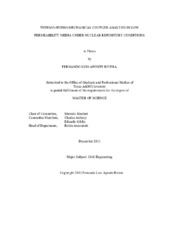| dc.contributor.advisor | Sanchez, Marcelo | |
| dc.creator | Aponte Rivera, Fernando Luis | |
| dc.date.accessioned | 2014-05-13T17:26:21Z | |
| dc.date.available | 2015-12-01T06:31:22Z | |
| dc.date.created | 2013-12 | |
| dc.date.issued | 2013-12-06 | |
| dc.date.submitted | December 2013 | |
| dc.identifier.uri | https://hdl.handle.net/1969.1/151838 | |
| dc.description.abstract | The design of underground repositories to storage high level radioactive waste is based on the multi barrier concept that consists of placing natural and artificial barriers around the radioactive material for isolation. The artificial barrier is commonly made of expansive clay (e.g. bentonite) that is subjected to heating and hydration resulting in Thermo-Hydro-Mechanical (THM) coupled phenomena. Experimental evidence has shown an important reduction in the hydration rate of the clay at advanced stages of infiltration tests under non-isothermal conditions. Traditional models have had problems to properly reproduce the hydraulic behavior observed in some experiments, overestimating the hydration rate and underestimating the time required to reach fully saturation conditions.
This thesis presents THM modeling of the FEBEX bentonite based on a mathematical framework suitable for problems in low permeability media. In addition, phenomena not included in traditional models like the threshold hydraulic gradient, thermo-osmosis and double structure are incorporated in the proposed framework to explain the reduction in the hydration rate.
In order to assess the performance of the models, infiltration laboratory tests performed under isothermal and non isothermal conditions and the mock-up large scale test carried out by CIEMAT, are presented. Additionally, a synthetic in-situ exercise sponsored by the eFEBEX project to study the THM evolution of a full scale bentonite buffer under typical repository conditions is also discussed. All numerical simulations were carried out with the finite element program CODE_BRIGHT and divided into four cases: a reference case, (based on the standard THM formulation) and the other three correspond to advance model incorporating the following phenomena: the threshold hydraulic gradient, thermo-osmosis and double structure effects.
The models incorporated in the existing THM formulation enable the improvement of numerical predictions of the experimental data obtained from the infiltration tests and mock-up experiment by reproducing the reduction in the hydration rate inside the bentonite. It has been observed that the double structure model that considers the two dominant pore levels and material fabric changes in the FEBEX bentonite provided a more satisfactory reproduction of the long-term experimental results. | en |
| dc.format.mimetype | application/pdf | |
| dc.language.iso | en | |
| dc.subject | THM coupled analysis | en |
| dc.subject | Nuclear repository | en |
| dc.title | Thermo-Hydro-Mechanical Coupled Analysis in Low Permeability Media Under Nuclear Repository Conditions | en |
| dc.type | Thesis | en |
| thesis.degree.department | Civil Engineering | en |
| thesis.degree.discipline | Civil Engineering | en |
| thesis.degree.grantor | Texas A & M University | en |
| thesis.degree.name | Master of Science | en |
| thesis.degree.level | Masters | en |
| dc.contributor.committeeMember | Aubeny, Charles | |
| dc.contributor.committeeMember | Gildin, Eduardo | |
| dc.type.material | text | en |
| dc.date.updated | 2014-05-13T17:26:21Z | |
| local.embargo.terms | 2015-12-01 | |


